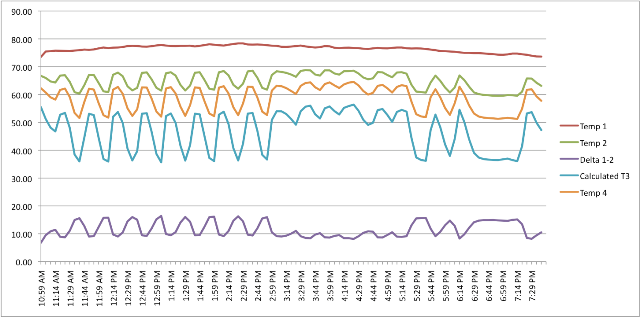|
November 2010
Column
AutomatedBuildings.com
|
[an error occurred while processing this directive]
(Click
Message to Learn More)
|
Networked Building Automation System (BAS)
It is amazing how little we know
about
what really goes on in most buildings.
|
Paul Ehrlich, Ira Goldschmidt
& Angela Lewis
Building
Intelligence Group
As published

November Issue - Column
|
It is amazing how little we know about
what really goes on in most buildings.
While much of what happens is none of our business, we are
concerned
about how key building systems are operating.
One of the greatest advantages of using a networked building
automation
system (BAS) is that we should be able to gain valuable insight into
system
operations. Unfortunately, what we often see is only a glimpse, an
observation
at a point in time that may not represent what is actually happening
the rest
of the time. There are several valuable
tools we would recommend for gaining better understanding into the
depths of
system operation.
Trend Logs:
[an error occurred while processing this directive]
Almost all BAS installations provide
the ability to trend system variables.
Trends (or trend logs) are typically configurable, and can be
set up to
occur at a fixed interval, or upon a change of value or state. While some systems come with a limited amount
of trending automatically enabled, most require the operator or
controls
contractor to set up the trends.
Defining a trend is a task that should be fairly easily
accomplished and
operators should receive instruction on doing this during training. Despite being a very valuable tool, we find
many systems where this function is rarely used. Why? --
There are several problems with BAS trends.
The largest problem is that the process to set them up is
generally not user
friendly; users need to set them up in anticipation of problems,
systems have
limited capacity to store trend data and the tools available to view
and manage
trend data are fairly limited. Most
systems provide the ability to view trend data, but to do in depth
analysis
typically requires exporting the data and analyzing it with a tool such
as
Microsoft Excel. The process of data
export can be tedious, and properly using spreadsheets requires skill
and
training. In short, we find that trends are a valuable, but often
underutilized
tool.
Data Loggers:
Another alternative for collecting
building system trend data is the portable data logger.
These devices are inexpensive, robust and
versatile. The ones we are use cost
around $100, come with built in temperature, humidity and light sensors
and
collect 43,000 data samples. They are
easy to set up and deploy and do a reliable job of collecting
information. When we are evaluating
buildings that don’t
have a current BAS installed the use of data loggers is the way to go. Data loggers are also be an excellent means
for validating and commissioning BAS.
Deploying a logger allows for ready measurement of values, both
providing verification as well as often being easier to set up and
analyze than
trend logs. Of course, the task of
analyzing the data typically comes back to the use of a spreadsheet.
So, again
good Excel skills are invaluable!
Detective Work:
The goal of data collection through
trends and loggers is to analyze how well the building is working over
time. Is
temperature control stable? Are systems
shutting off at night? Is the economizer
really working? The challenge is to use
this information to close the gap between a functioning building and
one that
is optimized. By collecting and
analyzing this data over time we can start to analyze proper operations
and
move toward high performance operations.
 Sample data log
of system during
commissioning
Sample data log
of system during
commissioning
About the Authors
 Paul
and Ira first worked together on a series of ASHRAE projects including the
BACnet committee and Guideline 13 – Specifying DDC Controls. The formation of
Building Intelligence Group provided them the ability to work together
professionally providing assistance to owners with the planning, design and
development of Intelligent Building Systems. Building Intelligence Group
provides services for clients worldwide including leading Universities,
Corporations, and Developers. More information can be found at
www.buildingintelligencegroup.com We also invite you to contact us
directly at
Paul@buildingintelligencegroup.com or
ira@buildingintelligencegroup.com
Paul
and Ira first worked together on a series of ASHRAE projects including the
BACnet committee and Guideline 13 – Specifying DDC Controls. The formation of
Building Intelligence Group provided them the ability to work together
professionally providing assistance to owners with the planning, design and
development of Intelligent Building Systems. Building Intelligence Group
provides services for clients worldwide including leading Universities,
Corporations, and Developers. More information can be found at
www.buildingintelligencegroup.com We also invite you to contact us
directly at
Paul@buildingintelligencegroup.com or
ira@buildingintelligencegroup.com
footer
[an error occurred while processing this directive]
[Click Banner To Learn More]
[Home Page] [The
Automator] [About] [Subscribe
] [Contact
Us]














 Paul
and Ira first worked together on a series of ASHRAE projects including the
BACnet committee and Guideline 13 – Specifying DDC Controls. The formation of
Building Intelligence Group provided them the ability to work together
professionally providing assistance to owners with the planning, design and
development of Intelligent Building Systems. Building Intelligence Group
provides services for clients worldwide including leading Universities,
Corporations, and Developers. More information can be found at
www.buildingintelligencegroup.com We also invite you to contact us
directly at
Paul@buildingintelligencegroup.com or
ira@buildingintelligencegroup.com
Paul
and Ira first worked together on a series of ASHRAE projects including the
BACnet committee and Guideline 13 – Specifying DDC Controls. The formation of
Building Intelligence Group provided them the ability to work together
professionally providing assistance to owners with the planning, design and
development of Intelligent Building Systems. Building Intelligence Group
provides services for clients worldwide including leading Universities,
Corporations, and Developers. More information can be found at
www.buildingintelligencegroup.com We also invite you to contact us
directly at
Paul@buildingintelligencegroup.com or
ira@buildingintelligencegroup.com